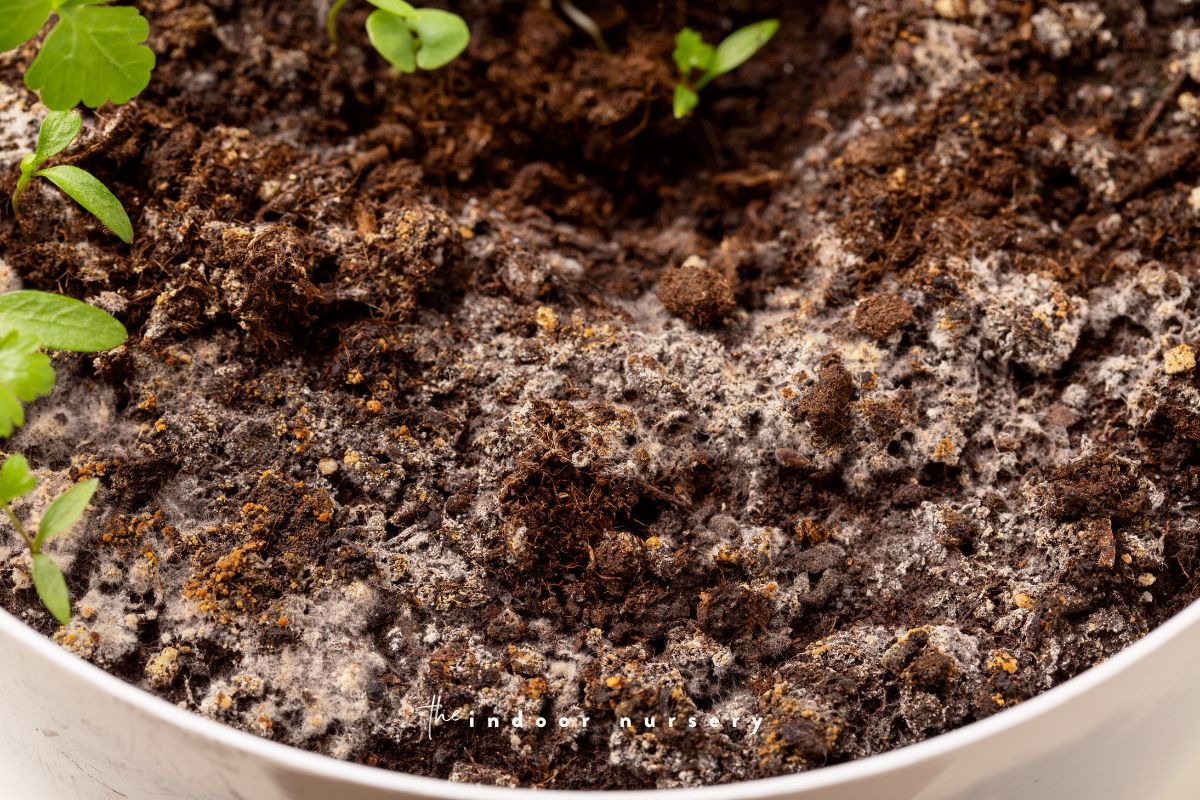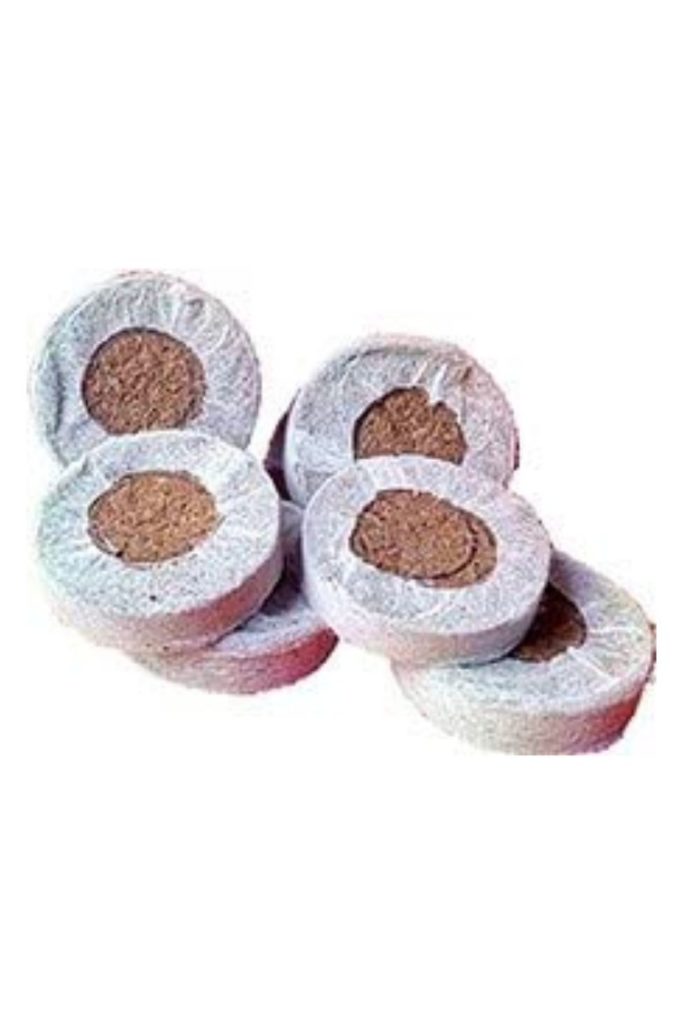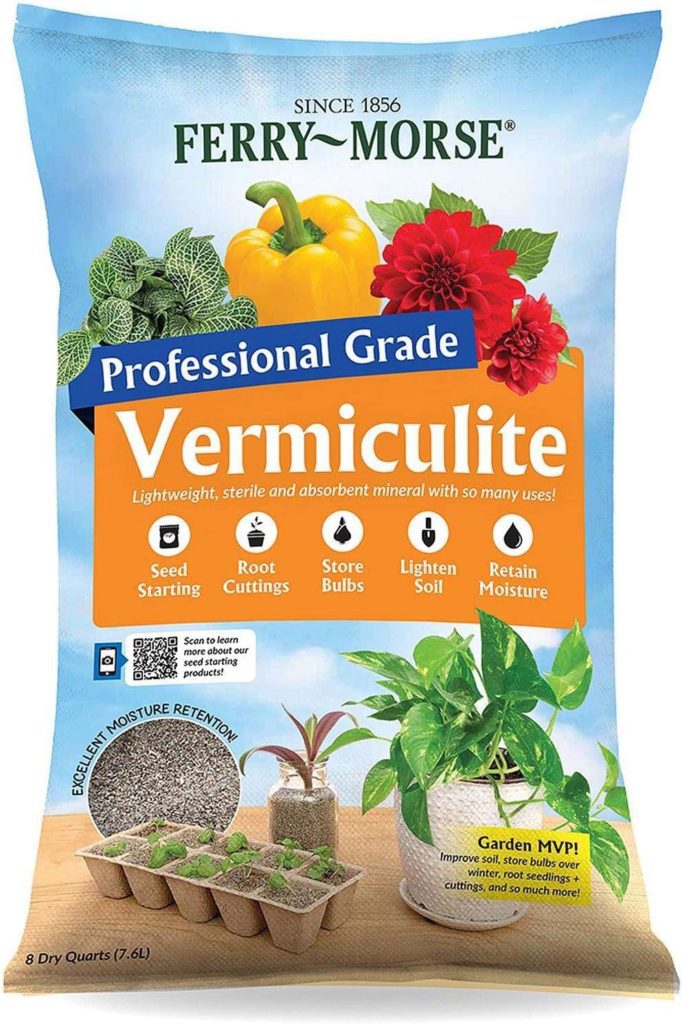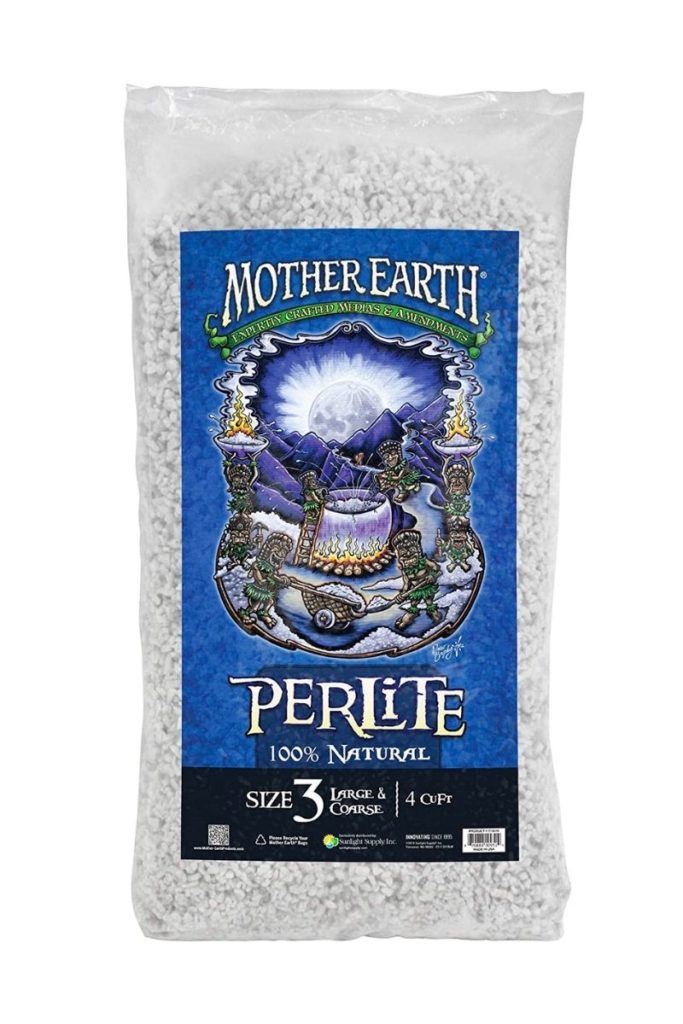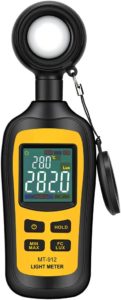I recently found mold on plant soil and I was a little disturbed by its fuzzy presence. 🥴
Even though fungi are integral to healthy soils, when you see any mold or mildew growing on top of potting soil or on the plants, it means something’s off balance with the plant’s growing conditions.
If it’s on the soil, it might be an easy fix, but if it’s on the plant, you’ll have to take more invasive action to prevent it from spreading further and potentially damaging the plant.
Luckily, there are lots of easy ways to get rid of mold and prevent it from growing on your houseplants!
What mold on plant soil looks like
You will usually notice mold growing on soil from its color contrasting against the dark brown to black dirt, or against the green leaves of your plant.
It might have some dimension, and look cottony, fluffy, fuzzy, or it may look like it’s sprinkled across the soil surface (be sure you’re not confusing the pearlite in your soil mix for fungal growth!)
The most common molds you might see include:
- White mold (usually a saprophytic fungus). White mold on houseplant soil can look like a dusting of white powder across the surface, or, if it’s more developed, like tufts of cotton or fuzz. This is a normal, and harmless, fungus that helps break down organic material, but its overgrowth means there is too much moisture in the soil. In severe cases, however, it may attract fungus gnats.
- Powdery mildew (a group of related fungi in the Erysiphaceae family). Powdery mildew is another white-colored mold that looks like a dusting of powder, but this one is found on the leaves and stems of a plant, and is splotchy in nature. A layer of powdery mildew can block the leaves from absorbing sunlight, interrupting photosynthesis and damaging the plant, and needs to be removed right away when you notice it.
- Gray mold (Scientific Botrytis name). Gray mold, like powdery mildew, is a dusty looking fungus that grows on plant stems and leaves, as well as on the soil just around the base of the plant. It has a medium to dark gray coloration to it, and this mold can harm or kill a houseplant by damaging leaf and stem tissue.
- Sooty mold (A group of molds including Aethaloderma and Capnodium). A black-colored mold that looks dusty, sooty mold shows up with a bigger problem: a scale infestation. Scale bugs feed on fleshy plant leaves and secrete a sugary substance called honeydew, which the sooty mold grows on. While the mold can weaken a plant’s photosynthetic activity, the real damage comes from the pests that eat away at the leaves.
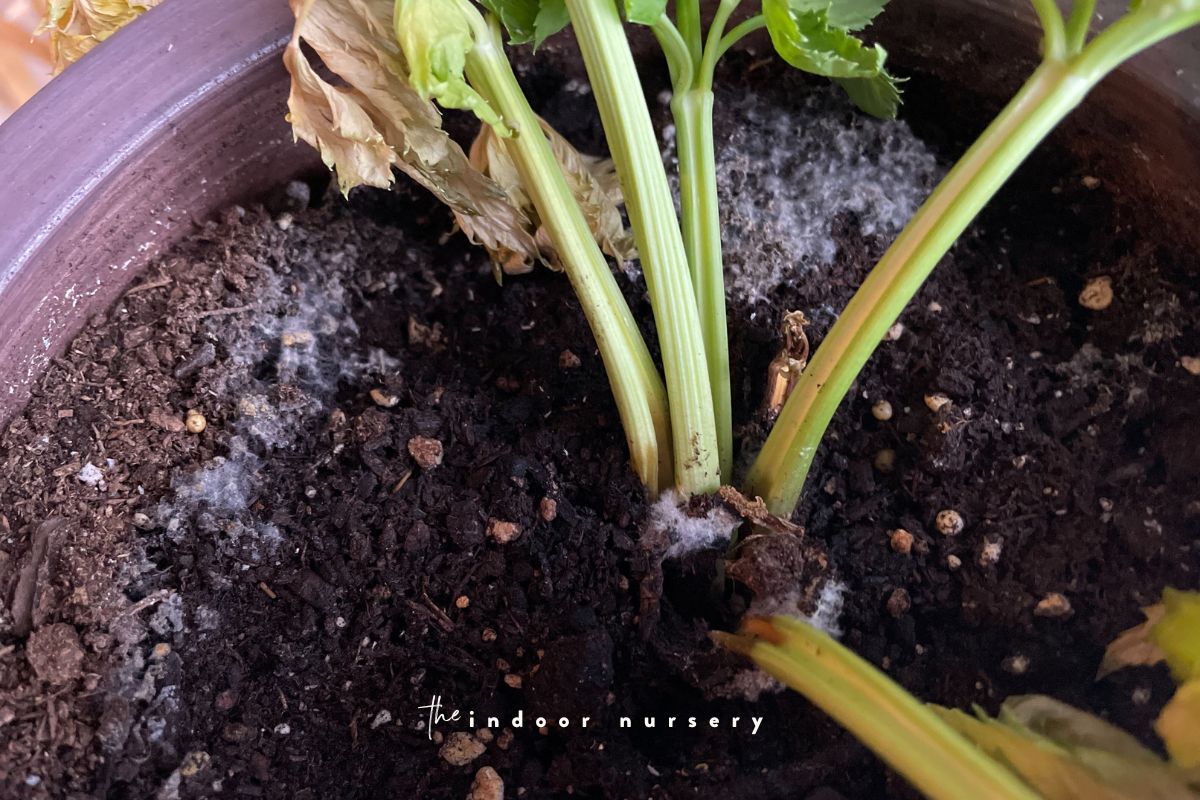
What causes mold growth on houseplant soil?
Ranging from annoying to damaging, mold growth on plants can be caused by a variety of environmental factors:
- Overwatering. Overwatering a plant is the main cause of mold growth. The excess moisture creates the conditions that mold thrives in, especially when it’s also cool and dark.
- Poor drainage. If a pot doesn’t drain, even regular watering can lead to a buildup of excess moisture that leads to a wet, humid environment that not only encourages mold growth, but can damage roots as well.
- Poor air circulation. Movement of air is important to keep mold spores from settling and to evaporate moisture so the soil and plant remain dry enough that mold can’t grow.
- Contaminated soil. When spores are already present in old soil or soil from outside, it’s easier for them to establish when conditions might turn in their favor.
- Decomposing leaves on the surface. Putting leaves on plants for mulch or fertilizer can help your plants retain moisture and receive a supply of nutrients, but that dark, moist space is also ideal for fungal growth.
Will moldy soil harm my plant?
While some molds may harm your plants and others may not, any mold growing in your soil means something’s off. If your plant is in too dark of a space, a location where air doesn’t move too much, or if the plant is receiving too much water, not only is mold encouraged to grow, but the plant itself won’t be in its healthiest condition to fight off potential damage from infection.
Mold and pests most easily take hold when a plant’s growing conditions aren’t ideal, so making a small environmental change can go a long way in keeping your indoor plants healthy and mold-free.
How to get rid of mold in plant soil
Getting rid of mold on plant soil is pretty straightforward. You can certainly treat it with the methods below, but repotting plants is a gentle and easy method too.
- Baking Soda Mold Treatment. Half of a teaspoon of baking soda and a quarter teaspoon of natural soap mixed in 2 liters, or a half gallon, of water can be used to spray, wipe down, and treat some kinds of mold. The baking soda damages the mold by making the plant’s surface and its soil too alkaline for the mold to survive without harming the plant.
- Vinegar Soil Mold Eliminator. Mixing a tablespoon of (white or apple) vinegar with 2-4 liters, or a half to full gallon, of water will disrupt mold growth when you use it to clean your plant or apply it as a preventative. The acidic property of vinegar is antifungal, while the diluted solution is gentle on plants.
- Hydrogen Peroxide Soil Treatment. Mix 1 part 3% hydrogen peroxide with 4 parts water for a solution you can use to clean certain types of mold off of plants with minimum effect on the plant itself. Hydrogen peroxide is water with an extra oxygen molecule, which oxidizes, and destroys, fungus and bacteria.
- Neem Oil Mold Eliminator. Mix 1 1/2 tablespoons of neem oil concrete with 1 teaspoon of mild liquid soap, and 1 liter of water for a solution you can use to spray or wipe down plants with mold or pest infections. Neem oil contains a molecule called Azadirachtin, which is used as an antifungal as well as a pesticide and disinfectant.
- Fungicide Treatment. Purchasing a retail fungicide is an effective method of removing and preventing mold growth. There are many formulas, from synthetic to organic, that treat different kinds of molds, as well as handy all-purpose preventatives that decrease microbial activity.
- Sunlight Soil Treatment. Mold grows best in dark, cool, moist places where it won’t dry out. Putting a plant in sunlight exposes it to UV rays that heat up and dry off a surface, so moving a plant with a mold problem into a brighter spot is an easy way to kill some molds and prevent future growth.
- Cinnamon Soil Treatment. Sprinkling a dusting of cinnamon over your soil surface can smother light mold growth and damage its structure: cinnamon has antimicrobial properties that help suppress many types of mold.
Identifying the plant mold
The first step to getting your plant back to optimal health is by identifying the problem so you can apply the proper solution.
- How to remove white mold from your plants. White mold is one of the easiest to remove from the surface of your plant’s pots. Agitating the soil, watering your plant less frequently, and giving the plant more light, as well as a little cinnamon, will keep this fungus off your plant. There’s no need for fungicides or baking soda to get rid of white mold in your potting soil. However, a vinegar and water mixture can be used for more severe cases.
- How to remove powdery mildew from your plants. Using a baking soda and water mixture is thought to be the best way to get rid of powdery mildew on an infected plant. Vinegar and water mixtures and hydrogen peroxide and water mixtures also work on powdery mildew, as do fungicides. Neem oil is effective in preventing powdery mildew spores from taking hold, and it can be used to eliminate light cases of powdery mildew growth.
- How to remove gray mold from your plants. Gray mold is one of the more damaging types of fungus that might find its way to your houseplant. If you notice the powder on the stems, leaves or branches of one of your plants, take it outside or into a shed or garage to isolate it so the mold doesn’t spread to other indoor plants, then use a clean, sharp razor or scissors to clip off infected portions of the plant. Once the mold is off and only healthy parts remain, remove the plant from the pot and throw out the contaminated soil. Wash the roots with water and a little natural soap to remove dirt and eliminate mold spores before repotting it in fresh soil and placing the plant in a well-lit, well-ventilated area.
- How to remove sooty mold from your plants. Sooty mold and the scale that it follows both need to be removed. Give attention to the source of the problem first: the scale bugs. Take the plant outdoors or into an isolated utility space and, using a cotton swab or a paper towel with diluted rubbing alcohol, wipe the bugs from the leaves. A good rinsing of the plant should help lift some of the bugs as well. You can then use vinegar and water or hydrogen peroxide and water mixture to clean off the sooty mold and honeydew from the leaves.
Adjust your watering schedule
Many fungus problems come from excess moisture, whether it’s too humid air or too wet soil. Reducing the amount of water that you give your plant at a time or allowing the soil to dry for longer between waterings will help prevent mold from being able to grow.
Ensure the potting mix and pot drain sufficiently
A well-draining pot is essential for preventing mold growth. When water builds up and saturates the soil, not only will It risk mold growth, it may lead to root rot. A potting mix with enough coarse material like gravel, sand or perlite will help move water downwards and out through the pot’s drainage holes.
Increase ventilation to prevent mold growth
The flow of air in a pot’s soil is as important as the water’s flow since mold grows best in still air. Since mold spores are so light in weight, keeping a fan or open window (weather permitting) will help circulate the air and prevent them from establishing, while also keeping the location dry.
Place the plant in a well-lit area
The amount of light an area gets can also have an effect on the ability for mold to grow. When plants are in dark places, the moisture in the pot can’t evaporate. The warmth of the sun both evaporates excess moisture and keeps the surface warm and dry so mold can’t grow.
You can use a PAR light meter to see how much sun your plant truly gets throughout the day.
more about common questions
- How To Get Rid Of Scale On Plants
- How To Treat A Magnesium Deficiency In Cannabis
- It’s Not O-K: Potassium Deficiency in Cannabis
- How To Make Pothos Fuller (In 5 Minutes)
- Save Your Overwatered Monstera In 4 Steps (And How Not To Do It Again)
- Scale On Monstera: What To Do And How To Save It
- Common Calathea Problems and How to Fix Them

